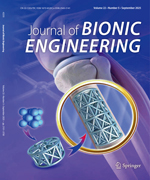|
|
Degradable and Tunable Keratin-fibrinogen Hydrogel as Controlled Release System for Skin Tissue Regeneration
Sung Jun Min, Jae Seo Lee, Haram Nah, Ho-Jin Moon, Sang Jin Lee, Hyeon Jeong Kang, Yu-Shik Hwang, Il Keun Kwon & Dong Nyoung Heo
Journal of Bionic Engineering. 2023, 20 (3):
1049-1059.
DOI: 10.1007/s42235-022-00317-7
Biodegradable hydrogels are promising biomaterials for use in controlled-release systems for skin tissue regeneration. Controlled delivery systems constitute an important aspect of tissue engineering because they can modulate various physiological responses, including early immune response, tissue remodeling, and cell proliferation and maturation in the wound-healing process. Hydrogels composed of various biomaterials have been developed to overcome the limitations of conventional drug- or protein-delivery systems, such as limited targeting ability, low stability, and the induction of drug resistance. Hydrogels based on keratin, a natural polymer extracted from human hair, can provide adequate cell support and control homeostasis. Consequently, they can be applied for skin tissue engineering. In this study, we prepared degradable, tunable, and biocompatible hydrogels for controllable protein delivery. We synthesized keratin-fibrinogen (KER-FBG) by the chemical coupling reaction and prepared hydrogels through polymerization with thrombin. The structures and morphologies of the KER-FBG hydrogels were confirmed. Furthermore, the mechanical properties, swelling ratio, degradation, release behavior, and biocompatibility were investigated. The KER-FBG hydrogels presented promising biological performance, indicating that the material is suitable as a controlled protein delivery carrier.
Related Articles |
Metrics
|

 Table of Content
Table of Content
 Table of Content
Table of Content